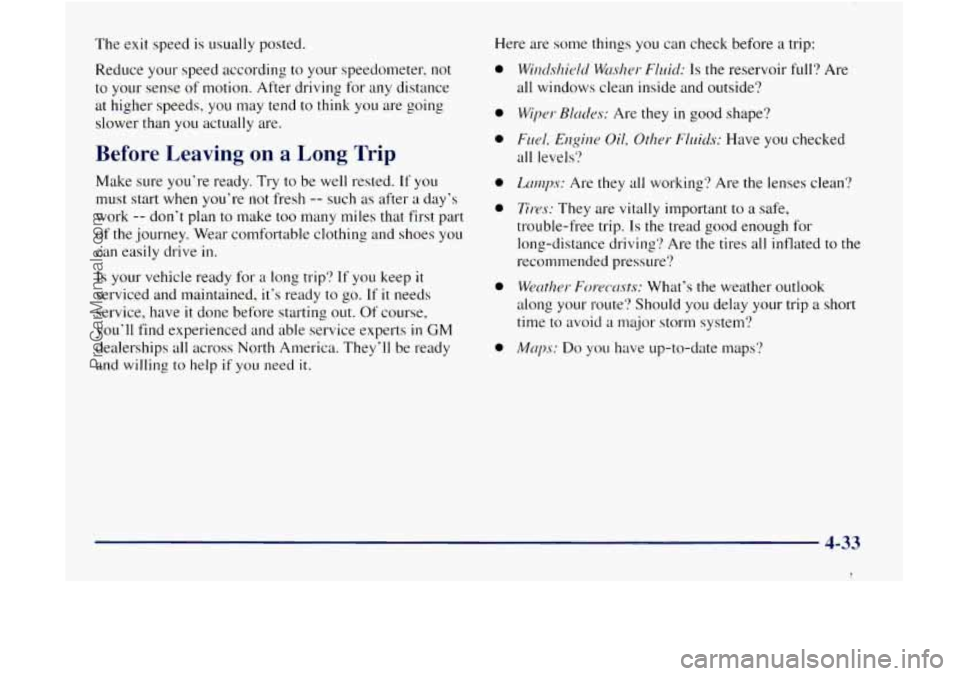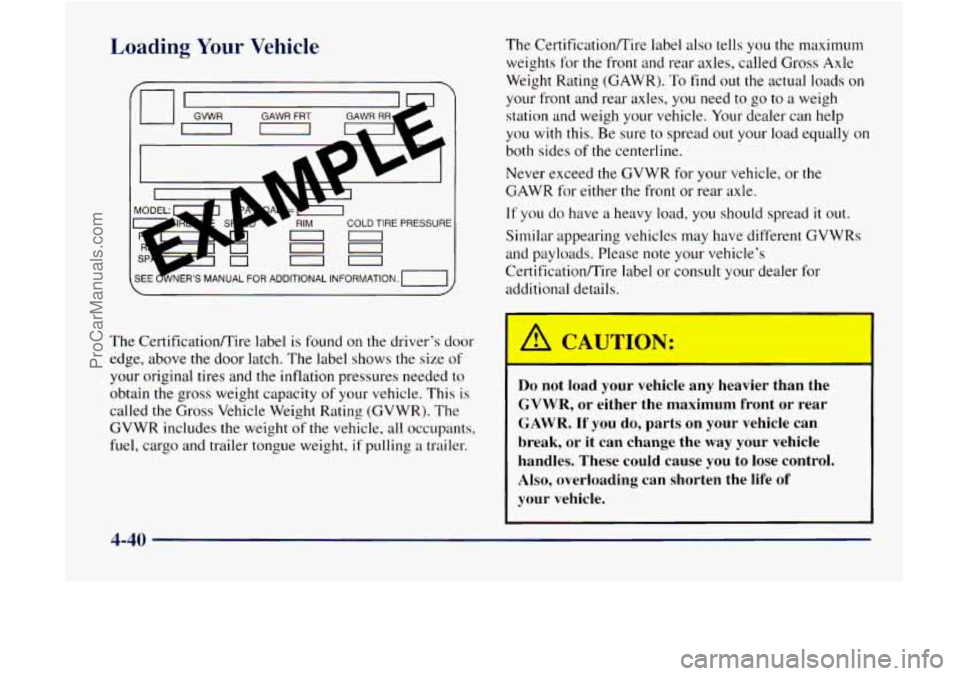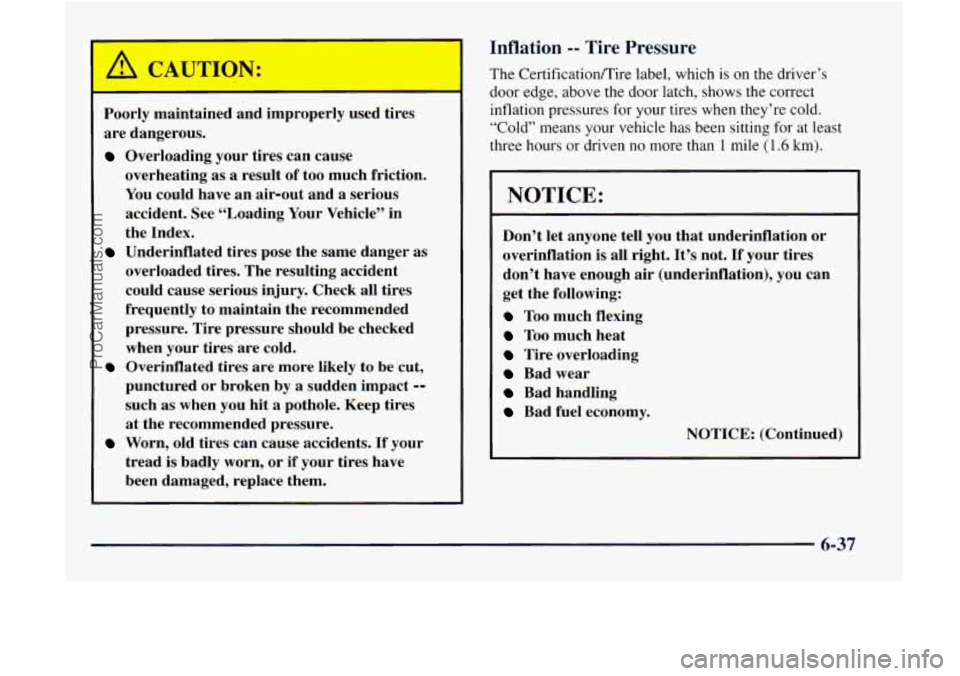1998 GMC ENVOY fuel pressure
[x] Cancel search: fuel pressurePage 6 of 386

1
Vehicle Symbols
These are some of the symbols you tnay find on your vehicle.
For example.
these symbols
are used
on an
original battery:
POSSIBLE A
CAUTION
INJURY
PROTECT EYES BY
SHIELDING
CAUSTIC
ACID COULD
BATTERY
CAUSE
BURNS
AVOID
SPARKS
OR
FLAMES
SPARK
OR ,111,
COULD FLAME
EXPLODE BATTERY
These symbols
are important
for you and
your passenpel-s
whenever your vehicle
is
driven:
DOOR LOCK
UNLOCK
FA$TEll SEAT
BELTS SIGNALS
TURN
RUNNING
.':**o
DAYTIME LAMPS
*
FOG LAMPS $0
WINDSHIELD
WIPER
WINDSHIELD DEFROSTER
WINDOW
DEFOGGER
VENTILATING
i F,
FAN COOLANT
-
TEMP -
CHARGING I-1
BATTERY
SYSTEM
BRAKE
(a)
COOLANT a
ENGINE OIL w,
PRESSURE
ANTI-LOCK
(@)
BRAKES
Here are some
other symbols
you may see:
FUSE
P
LIGHTER m
HORN b
SPEAKER
b
FUEL p3
V
1
ProCarManuals.com
Page 130 of 386

Have you recently changed brands of fuel?
If so, be sure to fuel your vehicle with quality fuel (see
"Fuel"
in the Index). Poor fuel quality will cause your
engine not to run as efficiently
as designed. You may
notice this as stalling after start-up, stalling when you
put the vehicle into gar, misfiring, hesitation on
acceleration or stumbling on acceleration. (These
conditions may go away once the engine
is warmed up.)
This will be detected by the system and cause the light
to turn on.
If you experience one or more of these conditions,
change the
fuel brand you use. It will require at least one
full tank of the proper fuel to turn the light off.
If none of the above steps have made the light turn off,
have your dealer or qualified service center check the
vehicle. Your dealer has the proper test equipment and
diagnostic tools to
fix any mechanical or electrical
problems that may have developed.
Engine Oil Pressure Gage
The oil pressure gage shows
the engine
oil pressure in
psi (pounds per square inch)
when the engine is running.
Canadian vehicles indicate pressure
in kPa (kilopascals).
Oil pressure may vary with engine speed, outside
temperature and oil viscosity, but readings above the
low pressure zone indicate the normal operating range.
A reading in the low pressure zone may be caused by a
dangerously low
oil level or other problems causing low
oil pressure.
2-69
I
ProCarManuals.com
Page 192 of 386

The exit speed is usually posted.
Reduce your speed according to your speedometer’
not
to your sense of motion. After driving for any distance
at higher speeds,
you may tend to think you are going
slower than you actually are.
Before Leaving on a Long Trip
Make sure you’re ready. Try to be well rested. If you
must start when you’re not fresh
-- such as after a day’s
work
-- don’t plan to make too many miles that first part
of the journey. Wear comfortable clothing and shoes you
can easily drive
in.
Is your vehicle ready for a long trip? If you keep it
serviced and maintained, it‘s ready to go. If it needs
service, have
it done before starting out. Of course,
you’ll find experienced and able service experts
in GM
dealerships all across North America. They’ll be ready
and willing to help if you need it.
Here are some things you can check before a trip:
0
0
0
0
0
0
0
WincJsl~ield Wcrshc~r- Fluid: Is the reservoir full? Are
all windows clean inside and outside?
Wiper Blcrdes: Are they in good shape?
Fuel, Elzgirze Oil, Other Flr.ds: Have you checked
all levels‘?
Lcunps: Are they all working? Are the lenses clean?
Tires: They are vitally important to a safe,
trouble-free trip.
Is the tread good enough for
long-distance drivingi? Are the tires all inflated
to the
recommended pressure?
Wecrther Forec*cr.sts: What’s the weather outlook
along your route? Should
you delay your trip a short
time to avoid
a major storm system?
A4crp.s: Do you have up-to-date maps?
4-33
I
ProCarManuals.com
Page 199 of 386

Loading Your Vehicle
The CertificatiodTire label is found on the driver’s door
edge, above the door latch. The label shows the size of
your original tires and the inflation pressures needed to
obtain the gross weight capacity
of your vehicle. This is
called the Gross Vehicle Weight Rating (GVWR). The
GVWR includes the weight of
the vehicle, all occupants,
fuel, cargo and trailer tongue weight, if pulling a trailer. The
Certification/Tire label
also tells you the maximum
weights for the front and rear axles, called
Gross Axle
Weight Rating (GAWR).
To find out the actual loads on
your front and rear axles, you need to go to a weigh
station and weigh your vehicle. Your dealer can help
you with this. Be sure to spread out your load equally on
both sides of the centerline.
Never exceed the GVWR for your vehicle,
or the
GAWR for either the
front or rear axle.
If you do have a heavy load, you should spread it out.
Similar appearing vehicles may have different GVWRs
and payloads. Please note your vehicle’s
Certificatian/Tire label or consult your dealer for
additional details.
I
A (- %I---- - -,
Do not load your vehicle any heavier than the
GVWR, or either the maximum front or rear
GAWR. If you do, parts on your vehicle can
break,
or it can change the way your vehicle
handles. These could cause you to lose control. Also, overloading can shorten the life of
your vehicle.
4-40
ProCarManuals.com
Page 248 of 386

Section 6 Service and Appearance Care
Here you will find information about the care of your vehicle. This section begins with service and fuel information,
and then
it shows how to check important fluid and lubricant levels. There is also technical information about your
vehicle, and a part devoted
to its appearance care.
6-2
6-3
6-5
6-5
6-7
6-8
6-
10
6-14
6- 15
6-19
6-20
6-2
1
6- 24
6-25
6-25
6-26
6-
2’7
Service
Fuel
Fuels in Foreign Countries
Filling Your Tank
Filling a Portable
Fuel Container
Checking Things Under the Hood
Engine Oil
Air Cleaner
Automatic Transmission Fluid
Rear Axle
Four- Wheel Drive
Engine Coolant
Radiator Pressure Cap
Thermostat
Power Steering Fluid
Windshield Washer Fluid
Brakes Battery
Bulb Replacement
Windshield Wiper Blade Replacement
Tires
Appearance Care
Cleaning the Inside
of Your Vehicle
Care of Safety Belts
Cleaning the Outside of Your Vehicle
Appearance Care Materials Chart
Vehicle Identification Number (VIN)
Service Parts Identification Label
Electrical System
Replacement Bulbs
Capacities and Specifications
Air Conditioning Refrigerants
6-30
6-3
1
6-34
6-36
6-45
6-46
6-48
6-50
6-53
6-54
6-54
6-54
6- 60
6- 60
6-62
6-1
ProCarManuals.com
Page 284 of 386

Poorly maintained and improperly used tires
are dangerous.
Overloading your tires can cause
overheating as
a result of too much friction.
You could have an air-out and
a serious
accident. See “Loading Your Vehicle” in
the Index.
Underinflated tires pose the same danger as
overloaded tires. The resulting accident
could cause serious injury. Check all tires
frequently to maintain the recommended
pressure. Tire pressure should be checked
when your tires are cold.
Overinflated tires are more likely to be cut,
punctured or broken by a sudden impact
--
such as when you hit a pothole. Keep tires
at the recommended pressure.
Worn, old tires can cause accidents. If your
tread is badly worn, or if your tires have
been damaged, replace them.
Inflation -- Tire Pressure
The CertificatiodTire label, which is on the driver’s
door edge, above the door latch, shows the correct
inflation pressures for your tires when they’re cold.
“Cold” means your vehicle has been sitting for at least
three hours or driven no more than
1 mile (1.6 km).
NOTICE:
Don’t let anyone tell you that underinflation or
overinflation is all right. It’s not.
If your tires
don’t have enough air (underinflation), you can
get the following:
Too much flexing
Too much heat
Tire overloading
Bad wear
Bad handling
Bad fuel economy.
NOTICE: (Continued)
6-37
ProCarManuals.com
Page 306 of 386

Name
RT TRN
RR PRK
TRL PRK
LT HDLP
RT HDLP
LT HI
RT HI
FR PRK
INT BAT
ENG
I
ECM B
ABS
ECM
1
HORN
BTS
I
BIU LP
IGN E
AIC
RAP
OXYSEN
Usage
Right Turn Signal Rear
Right Rear Parking Lamps
Trailer Park Lamps Left Headlamp
Right Headlamp
Left High Beam
Right High Beam
Front Parking Lamps
I/P Fuse Block Feed
Engine SensorsISolenoids, MAP,
CAM. PURGE, VENT
Engine Control Module, Fuel Pump,
Module, Oil Pressure
Anti-Lock Brake System
Engine Control Module Injectors Horn
Brake-Transmission Shift Interlock
Back-up
Lalllps
Engine
Air Conditioning
Retained Accessory Power
Oxygen Sensor
Name
IGN B
DRL
FOG LP
IGN
A
STUD #2
PARKLP
LR PRK
IGN C
HTDSEAT ATC
RRDFOG
HVAC
TRCHMSL
RR W/W
CRANK
LD LEV
HI BEAM
HAZLP
VECHMSL
HTDMIR
STOPLP
TBC
Usage
Column Feed, IGN 2, 3,4
Daytime Running Lamps
Fog Lamps
Starting and Charging IGN
I
Accessory Feeds, Electric Brake
Parking La~nps
Left Rear Parking Lamps Starter Solenoid, Fuel Pump. PRNDL
Heated Seat
Electronic Transfer Case
Rear Defogger
HVAC System
Trailer Center High Mount Stop Light
Rear Window Wiper
Clutch Switch, NSBU Switch
Electronic Load Leveling
HID Headlamps Hazard Lamps
Vehicle Center High
Mount Stop Lamp
Heated Mirror
Stoplamps
Truck Body Computer
6-59
1
ProCarManuals.com
Page 350 of 386

Part B: Owner Checks an - Services Engine Coolant Level Check
Listed below are owner checks and services which
should be performed at the intervals specified to help
ensure the safety, dependability and emission control
performance of your vehicle.
Be sure any necessary repairs are completed at once.
Whenever any fluids or lubricants are added to your
vehicle, make sure they are the proper ones,
as shown in
Part D.
At Each Fuel Fill
Engine Oil Level Check
Check the engine oil level and add the proper oil if
necessary. See "Engine Oil" in the Index for
further details. Check
the engine coolant
level and add DEX-COOL'
coolant mixture
if necessary. See "Engine Coolant'' in
the Index for further details.
Windshield Washer Fluid Level Cl: -.
Check the windshield washer fluid level in the
windshield washer tank and add the proper fluid
if
necessary. See "Windshield Washer Fluid" in the Index
for further details.
At Least Once a Month
Tire Inflation Check
Make sure tires are inflated to the correct pressures. See
"Tires"
in the Index for further details.
Cassette Deck Service
Clean cassette deck. Cleaning should be done every
SO hours of tape play. See "Audio Systems" in the
Index for further details.
7-39
ProCarManuals.com